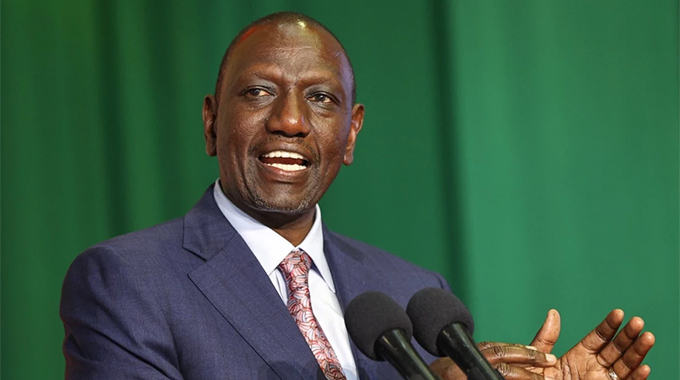Retired civil servant ready to export 40 tonnes of peas to Europe

Patrick Chitumba
GWERU-based farmer, Mrs Matilda Manhambo says she is ready to export over 40 tonnes of peas to Europe and the United Arab Emirates as she has started harvesting and grading the product for the foreign market.
Last year, she exported 18 tonnes of peas to the Netherlands.
Mrs Manhambo (65) has carved a niche for herself in the field of horticulture and now has a peas export licence, meaning she is no longer exporting her product through an agent or a third party.
The Second Republic has been on an economic diplomacy path as part of re-engagement efforts with Western countries. As a result, previously closed markets are now opening up to the private sector, much to the benefit of farmers like Mrs Manhambo, the owner of the 196 hectare Kupfumaishungu Farm.
Mrs Manhambo, a retired civil servant who served in Government for 36 years, recently hosted a peas field day at her farm located about 15km from the Gweru Central Business District where other farmers took notes on how to grow and export the cash crop.
At the farm, over 50 employees, 20 of whom are permanent, were busy picking peas from the fields.
Some of them were grading the peas.
The graded peas were packed in trays and stored in a container truck that has been converted into a cold room.
A holder of a Diploma in Accounting, Mrs Manhambo joined the public service as a clerk in the Department of Research under the Ministry of Agriculture.
She rose through the ranks to become a senior executive officer.
Mrs Manhambo said: “Right now I have peas on five hectares and we are expecting about 10 tonnes per hectare. We are ready to export over 40 tonnes of peas to Europe and the United Arab Emirates. As you can see, we have started harvesting and grading the product for the foreign market.”
She also has the Global Good Agricultural Practices (GAP) certificate that outlines international standards that safeguard food safety, workers’ health and safety, animal welfare, and environmental protection.
“I have the peace export licence and can now export on my own. Before I used to export through agents who demanded commission. Some are still to pay me for the peas I exported last year. So, I am grateful to the Government for availing opportunities for us to have such licences,” said Mrs Manhambo.
She said she also has a Sedex Members Ethical Trade Audit (Smeta) certificate.
Smeta is the most widely used format for social audits in the world, enabling businesses to assess their sites and suppliers to understand working conditions in their supply chain.
“The GAP and the Smeta certificates are required by the international market for us to export. With GAP, even the working standards of our employees are monitored meaning what we do at this farm acts as a safeguard for food safety, workers’ health and safety and animal welfare and environmental protection,” she said.
Mrs Manhambo said she was assisted by the country’s trade promotion body, Zimtrade, to acquire certification, which is necessary for one to venture into the competitive export market.
She said she attended several training programmes under Zimtrade, notably the “Next She Exporter”.
The “Next She Exporter” programme caters for women entrepreneurs in various sectors of the economy with the exception of mining, fuels and electricity.
It is the first of its kind in Zimbabwe and is expected to grow female entrepreneurs and contribute to Zimbabwe’s competitiveness in both regional and global markets.
Mrs Manhambo, who is the Midlands provincial chairperson for Farmers for Economic Development (Farmers4ED), said she is already working on adding two more hectares to be put under peas.
“We are slowly growing and expanding our hectarage under peas as we are targeting to have seven hectares by the end of the year. We have also formed a cluster for peas farmers from Gweru so that we work together to sell our product at the same time because that way we also cut on transportation costs as we all share costs,” she said.
Kupfumaishungu Farm specialises in horticulture, livestock, poultry, piggery, goats and sheep production.

Mrs Manhambo picking peas with her workers
“We have 20 permanent employees and hire others especially when it’s time for harvesting,” she said.
Mrs Manhambo ventured into farming in 2006 after being allocated land by the Government under the land redistribution programme.
She is also into flower export and has markets in the Netherlands, United Kingdom and Germany as part of efforts to boost export earnings.
Mrs Manhambo started growing flowers last year in March.
“I am grateful to the Government for the funding we get from AFC Holdings and other partners such as Seedco who are always there to assist farmers like myself,” she said.
Mrs Manhambo said at the moment, she is facing power challenges – a development that has forced her to cut on producing other crops such as tomatoes and butternut.
“We are facing a lot of load shedding and that affects our irrigation. Because of that, we have scaled down on other crops as we channel the water pumped when we have power to the peas and flowers,” she said.
Seedco agronomist Mr Bright Musakanda said the peas field day sought to highlight and educate farmers on how to farm and export peas to Europe and other markets.
“We are here at this farm to show other farmers how the crop is grown. We have a healthy peas crop at this farm which is very good because the farmer is assured of high returns from the export market. Mrs Manhambo has established herself as a serious peas farmer and we believe her experience and knowledge can be imparted to other farmers,” he said.
Horticulture contributes 6,5 percent to total agricultural output and 0,7 percent of Zimbabwe’s total gross domestic product (GDP).
The Government last year introduced a US$30 million horticulture export revolving fund to spur horticulture export growth, as well as fulfil the dictates of the Horticulture Recovery and Growth Plan (HRGP).
This is in addition to other incentives such as suspension of duty on agriculture capital equipment (SI. 6 of 2016), anchor farmer incentive, value added tax (VAT) zero rating of farm inputs and foreign currency account (FCA) retention on incremental export receipts of 100 percent.
The Horticulture Recovery and Growth Plan being operationalised aims to boost the output of key commodities such as blueberries, fresh produce, citrus, macadamia, coffee and high-value emerging crops such as industrial hemp and medicinal cannabis.
ZimStats figures on external trade for the period January to November 2022 show that the country exported horticulture produce worth US$70 909 597 last year against US$70 611 813 for the same period in 2021.
In the formulation of the National Development Strategy 1 (NDS 1), the Government committed to, not only grow the agriculture sector as a major driver of economic growth, but to increase the value of agricultural production through value addition and beneficiation. – @pchitumba1










Comments